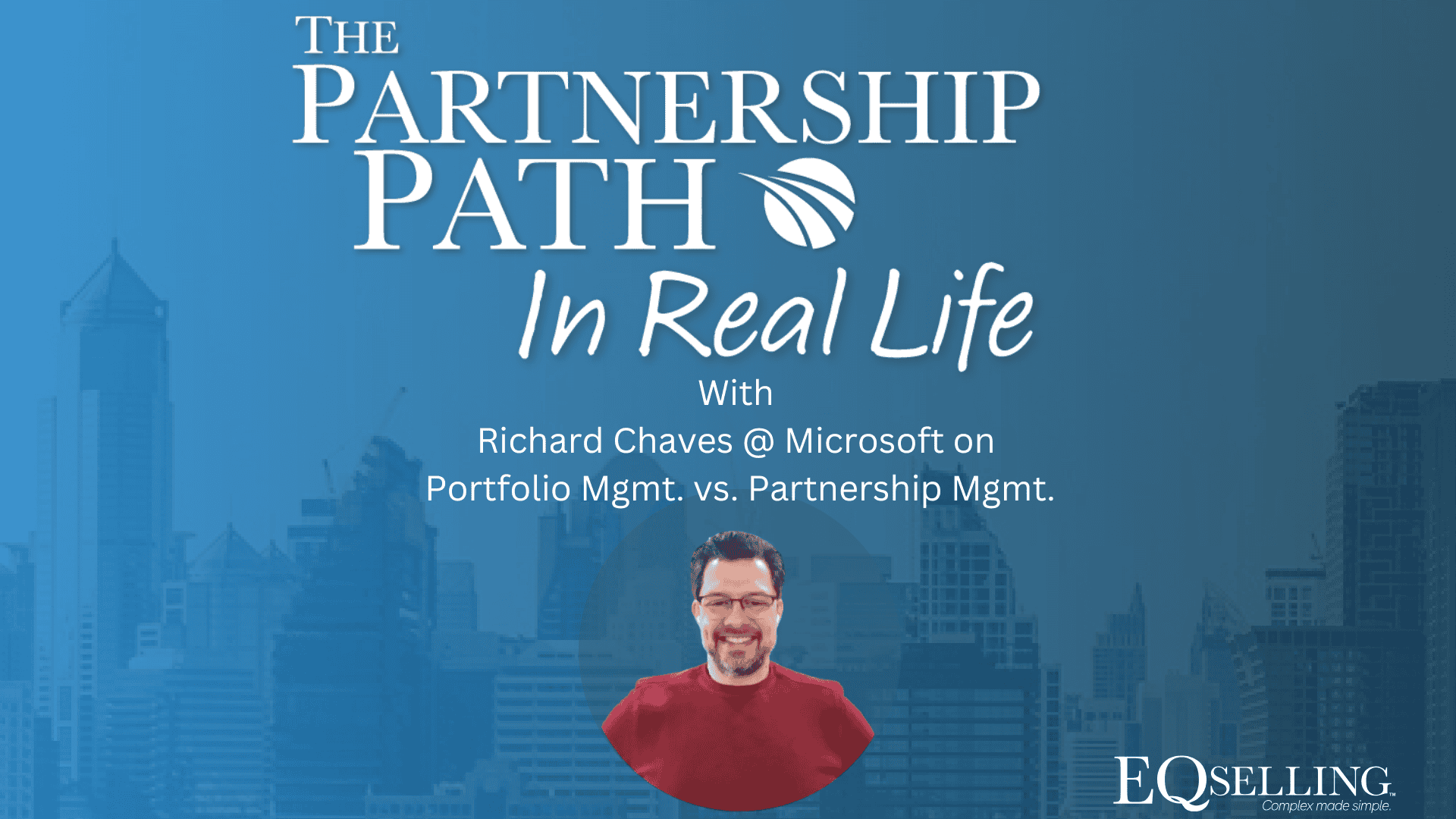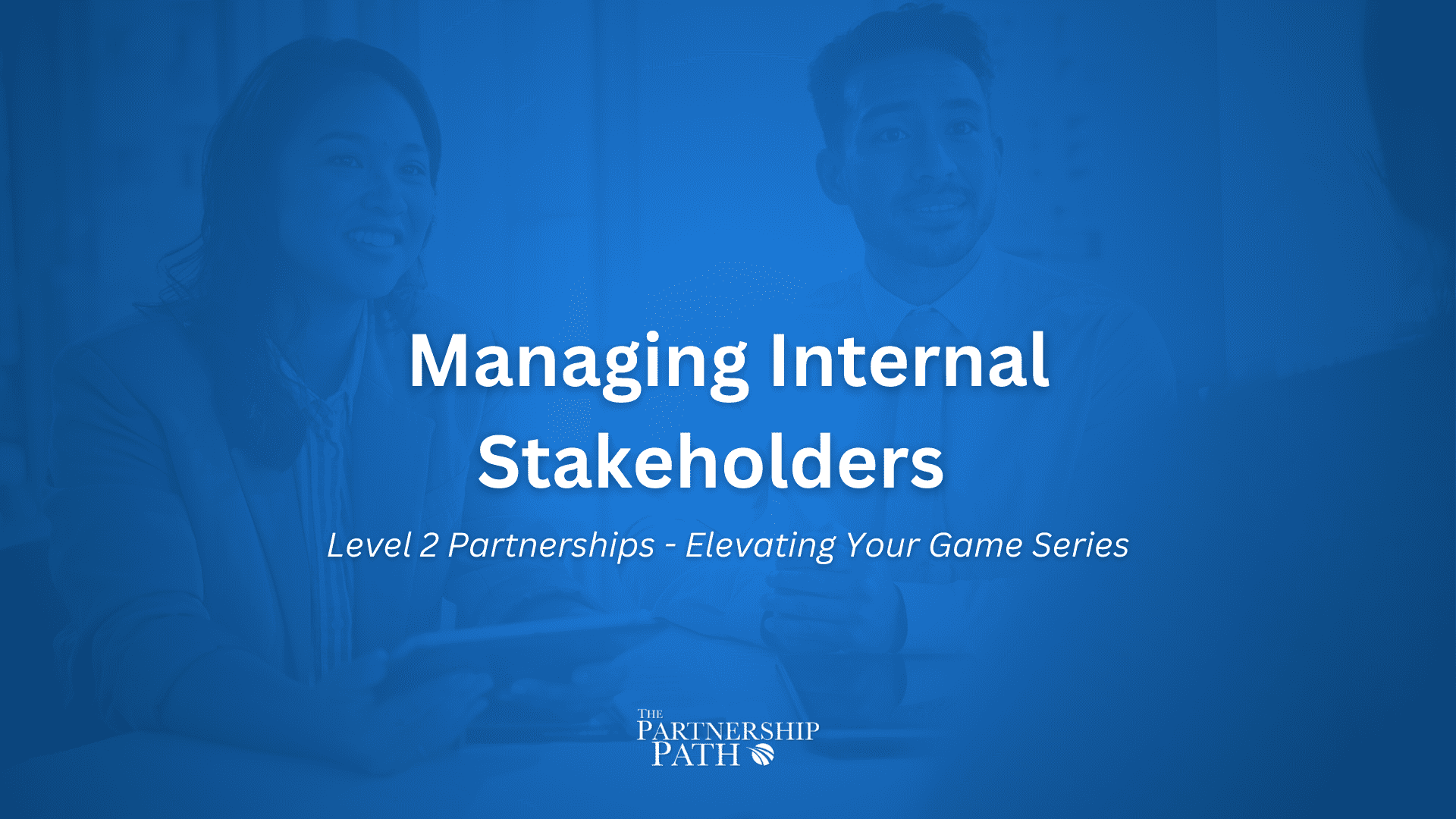Main Episode
Portfolio Management vs Partnership Management
Episode Summary
In this insightful episode of “The Partnership Path”, John and Toni discuss a critical topic for channel managers—“Portfolio Management vs Partnership Management.” John breaks down the subtle yet impactful shift from a one-on-one partner approach to a portfolio-wide view, which allows managers to optimize time, resources, and growth potential.
This episode provides a practical approach for maximizing partner impact, especially when balancing high-performing partners with those requiring more investment. This approach helps drive sustainable revenue by allowing managers to focus on scalable, big-picture growth.
Transcript
John (00:01)
Well, hello, Toni, and welcome to our first episode of season three of The Partnership Path. Good to see you again.
Toni (00:10)
Likewise, John, good to see you. Raring to go.
John (00:14)
I am ready. I’m excited about this season and we’re starting off with a strong topic and I’m just super excited.
Toni (00:22)
Yeah, so portfolio versus partnership. Is that where we’re at, John? Is that today?
John (00:26)
That is, gonna, yeah, we’re gonna talk about this macro versus micro kind of perspective, right? That in the time that I’ve spent working with partners and then training partner managers and stuff, I think one of the things that channel people sometimes struggle with is only looking at it on a partner by partner basis. They look at their business, one partner.
at a time, which is great until the fact of the matter is that you as a channel manager or partner account manager, whatever, you have a quota to meet that doesn’t matter. It’s not partner by partner. It’s rarely partner by partner. You’re you just have a number that you’re supposed to produce with that collection of partners and partnerships. And so it requires a little like you have to start to think about it as
Toni (00:57)
Yeah.
Yeah.
John (01:24)
portfolio and there are some implications to that. There’s implications on how you allocate time and resources. There’s allocations on the kind of metrics you should be watching. There’s implications on kind of the business rhythm you should have in place.
Toni (01:42)
Yeah, and I guess it’s very much like running. was once told, know, treat it like you are running your own business. Yeah, yeah, and it’s hard. don’t, I don’t think I know anybody right now that’s just working with one unless you’re a global alliances manager, which is a whole different kettle of fish, as we would say. Most people will have a and sometimes a significant one that is tiered.
John (01:51)
That’s exactly right, yeah.
Right. Yeah. Yep.
Toni (02:11)
So great topic to start off with.
John (02:14)
Well, and I would even in that, even in your example, Toni, I would challenge that somebody who has a global account, they may have one account, but they’re actually managing multiple partnerships. They have a portfolio of partnerships that happen to be all in that same account. And so the concepts we’re gonna talk about here apply in that scenario as well. And it’s, I also, I don’t wanna lose that thought either about run it,
Toni (02:21)
Mm.
Yeah.
The end.
Yeah.
John (02:44)
like a business. when you say that, or at least when I say that to people, a lot of times their first reaction is, I don’t have the kind of control that I would if I was running my own business. And so sometimes I say, OK, I’ll grant you that. So really the right phrase is run it like it’s a franchise. And I don’t know if you’ve ever talked to somebody who owns like a McDonald’s franchise or, you know, right? They own the business.
Toni (02:57)
you
Yeah.
John (03:14)
But they have to operate within certain parameters. can only, their labor costs have to meet certain thresholds. Their inventory costs have to be within a certain threshold. And that’s not their decision. That’s actually controlled by the franchise company. So it’s much more similar to that. Yeah, it’s a…
Toni (03:35)
Yeah, that’s a show.
John (03:40)
for a partner account manager, partner channel manager. If you haven’t ever talked to a franchise manager, go find one and ask them what’s easy and hard about their business. And then you’ll be like, yeah, that’s kind of similar to what I have to do. So yeah.
Toni (03:53)
Yeah, yeah, I think that’s a really good shout and it was funny, I kind of smiled because you reminded me of my old next door neighbour used to operate a McDonald’s franchise. Yeah, yeah, and it was just, was interesting because he was just, he was so proud. And I think the car you would get given was like a Mercedes A-Class or something. So was outside polishing his Mercedes A-Class going, this is what you get for being McDonald’s franchise manager.
John (04:03)
yeah.
Nice. Yeah.
Toni (04:23)
But yeah, but it was, but I think that the thing to kind of, guess, a serious point about that was he took as much pride in that as if it were his own business. So yes, there were parameters that he had to operate within, but it was his baby.
John (04:23)
Yeah!
That’s right. That’s right. Yeah. Yeah.
Yeah, yeah. So the thing we talk about that’s probably paramount in this idea of portfolio, I said there were kind of three things that get impacted, right? And the first is your time and resource allocation. And the reality is whether you’ve got five partnerships or 20 partnerships, or if you’re a tele-PAM or whatever and you got 200 partnerships, you have to decide
Toni (04:54)
Yeah.
John (05:09)
How am I going to treat each one of those partners? Because I can’t treat them all the same. Even if I’ve only got a small number of partnerships, I have to kind of start to think about where am I going to invest? Like, where am I going to over invest? Which partners am I going to really put my heart and soul and my resources into? Because I believe there will be an exponential payback versus which partners am I going to kind of give them just enough
Toni (05:23)
Yeah.
John (05:38)
to make sure that they continue to produce and grow the way I need them to versus which partners am I gonna kind of be reactive to and not really spend a lot of time in that? And I would argue, go ahead, yeah.
Toni (05:52)
So, you’re always just thinking, and this is probably what you’re coming onto, but within that context, lots of people, they are given their portfolio, let’s say, they’re supposed to be a handover. Very often there is not a handover. So if you’re coming in and going, okay, this is what I’ve got. How do we think about stack ranking those partners so we can go high potential maintenance?
John (06:05)
Yeah. Yeah, yeah.
Yeah.
Toni (06:22)
reactive only. Yeah.
John (06:22)
Yeah, reactive. Yeah. And here’s where I think the trick is too, is it depends on the other partnerships in your portfolio. It’s all relative to what you own. I may have a partnership that I’m treating in my portfolio like a maintenance sort of partnership, but when that partnership gets shifted into somebody else’s portfolio,
Toni (06:52)
Mm-hmm.
John (06:52)
It may become either a growth invest kind of partner or it could become a reactive partner based on who’s in that other portfolio. You know what I mean? It’s about a single individual and this is what I’ve got. This is what I’m supposed to produce. How am going to do that with what I’ve got? that’s not a mentality that a lot of channel people necessarily have.
Toni (07:04)
Yep.
Yeah.
John (07:22)
right out of the gate, right? They have to kind of learn that whole mentality of I need to be thinking about this as a business, as a franchise. Here’s what I’m supposed to produce. How the heck am I going to do that with what I was given? Because if I just go partner by partner, it’s not going to work. I’m not going to get there. I’ve got to be smarter about, OK, I think if I invest here, I’ll get double the payback. These people I’m going to just treat
Toni (07:32)
Hmm.
Mm.
No.
John (07:50)
I’m going to give them just enough. like, I’m, you know, I’m just going to feed them just enough so that they grow 10 % or whatever. And then these people, they’re, and it’s, here’s what I think is interesting too, is I may take a really good partner, somebody who just, you know, shows up every week produces that may be my reactive partner because they don’t need me. I don’t need to invest in them. Right.
Toni (07:57)
Hmm.
Yeah.
And there’s a point that you sort of touch on there, which is that a partner like that might have great run rate. So you’ve got a partner and they’re like, we don’t need you. Thank you, lovely partner account manager. they have that they’re doing their deals. And actually that could work for you. So whilst you may feel like you need to pay them a lot of attention because they’re doing the number, they’re coping all right. So where could you?
John (08:27)
Yeah.
Yep. Yep.
That’s right. Yeah.
Toni (08:46)
put your attention to grow another partner.
John (08:50)
So you have, as usual, Toni, you have keyed in on like the hardest decision in this whole discussion, which is for a partner account manager, channel manager, whatever, to say in all honesty, what would happen, how much would get produced if I don’t show up?
Toni (09:11)
Yeah. Yeah. Yeah.
John (09:13)
Right? It’s sobering, especially like, you know, in a direct sales job. That’s a much easier question because the answer is usually pretty low. If I’m not out there actively selling, nothing’s going to happen. But in a channel job, the truth of the matter is, is that your partners are going to produce a fair amount, whether you show up or not. The question is, is do you recognize where you have impact versus where you don’t?
Toni (09:19)
Mm.
Yeah.
Yeah.
John (09:42)
or where you could have impact versus where you’re not. And that’s hard. That takes a lot of self-awareness, a lot of honesty, and sometimes a lot of tough conversations with your managers and superiors about why you’re doing what you’re doing. Because like what you talked about, I would imagine at Microsoft, you had managers who said, you need to spend time with this partner because they’re our biggest producing partner.
Toni (09:46)
Hmm.
you
John (10:12)
When in reality, that partner didn’t want to have, they didn’t need you, they didn’t want to spend time with you. Like they needed you when they needed you. Right?
Toni (10:12)
Yeah
Yeah, so this is the end of of quarter and it can you get this deal across the line for me? Can you work with operations to get this paperwork done? That that was the that was the stuff that you know, help me make this deal happen in the way that it needs to happen. Yeah, definitely, definitely or I need to meet my counterpart make that happen for me.
John (10:25)
Yeah.
That’s right.
Toni (10:49)
Yeah, so you’re quite right. It is that identifying where can you actually add value and what does that look like can be difficult because you want to be hanging around the partner that’s doing all the glory stuff, definitely.
John (10:57)
Yeah. Yeah.
That’s right. Yeah. Yeah. And sometimes the partner that you should be investing in is the partner that actually has a really well-functioning, strong practice around your competitor. Right? They’ve got a, you work for Microsoft and they have a great Google practice or they have a great Amazon practice.
Toni (11:26)
Mm-hmm. Yeah.
John (11:29)
that might be the partner you should be investing in because if you could get them to apply those same techniques to your technology, you could see exponential growth. And that’s not how we always think. We think more like, where is the money? I’m going to go where the money is, not where could the money be and could I impact making that happen? And that’s what this portfolio versus partnership is really about, thinking big picture like that.
Toni (11:41)
Yeah.
And how do you communicate with, let’s say you’ve got a partner portfolio, how much do you want to expose to those partners, this is how I’m going to work with you and this is why? What’s your theory on that?
John (12:16)
I think my advice, generally speaking, is to be relatively transparent on that, at least on here’s how I’m going to work with you, not necessarily the why. If they push you on that, I think it’s okay to say, well, look, here’s if you really want to understand that, let me show you what I am faced with, what my portfolio looks like. And here’s how I’m making those decisions.
But generally, that’s not something a partner is actually interested in. They’re interested in what am I going to get from you? And so if I can be super clear with them, here’s how I’m going to engage with you, then I think you should be really transparent about that. Here’s how I’m going to work with you. Now, the difference between a grow and invest type of partnership and a maintain partnership, it’s not…
Toni (12:49)
Yes.
John (13:11)
drastically different in terms of the tasks that you’re going to do. What’s different is how much time you’re going to spend on them, right? As I’m going to spend a lot more time on these tasks with my growing invest partners to try and make something happen that isn’t happening versus with maintain. I’m just trying to keep things moving, right? I’m just trying to get them going. And I should be clear too. I think there are some pretty clear percentages, right? Like,
You know, we have lots of people that I share this with who then say, well, all of my partners are grow invest partners. And we say, well, you’re missing the point. This is a time allocation issue, right? You have a limited amount of time. So, you know, who are you going to spend more time with versus versus less or whatever? And, you know, I think in a regular portfolio, you probably have maybe 20 % of your of your kind of kind of 20 to maybe as much as 30 or 40 percent.
Toni (13:45)
Yeah.
Yeah.
John (14:08)
is kind of grow invest and somewhere between like 40 and 60 % is maintained. And then just a very small percentage, maybe 10 could be as much as 20 % is reactive. Right? So the vast majority is maintained. I’m giving them just enough to keep them moving and growing. And then I’ve got a smaller set that I’m over-investing in. And I’m compensating for that with a smaller set that I am kind of de-investing a little bit.
Toni (14:10)
Hmm.
Yeah.
John (14:37)
reserving investment to be reactive. And so, you know, that’s our recommendation to try and work that out, kind of figure out how you do that.
Toni (14:40)
Hmm.
And how would you think about, you know, when I’m viewing my portfolio, like you said, you might have percentage, grow and invest percentage, maintain a percentage reactive. What goals would you set at a portfolio level versus what you might be doing at a partnership level?
John (15:03)
Yeah. Yeah. Yeah, I think and so, yeah, I think that’s where we should kind of close this out, right, is that the other thing that you then have to do is have some metrics that you’re tracking at that portfolio level. And those are things like if I have a quota to meet, essentially, I have a revenue objective, I should have a pipeline across my partnership. So how do I kind of consolidate the
Toni (15:10)
Yeah.
Yeah.
John (15:31)
the individual partnership pipelines into my pipeline, which also means I should probably be tracking forecast accuracy across my whole portfolio, right? Like I think it’s sort of pipeline, it’s pipeline generation activity, it’s forecast, it’s growth, right? Because those are the things that are gonna help you achieve the quota or the objective that you’ve been assigned.
regardless of which partner it comes from. Because the truth of the matter is, is your manager doesn’t really care which partner it comes from. They just care that you make the number, right? Yeah. So look, this can be a controversial topic, right? When we start to talk about treating partners differently within a portfolio, when we start to say, maybe this high performing partner is actually one of my reactive.
Toni (16:11)
Exactly. Yeah.
Yeah.
John (16:28)
kind of that’s the strategy I’m going to use with them. That can be a little bit controversial. So I’m super anxious to hear from the community how they think about this, how they apply this, what works, what doesn’t work, what’s their experience been. Would love to hear all of that. So let’s throw it out to our community. Guys, if you’ve got something to say about portfolio versus partnership, let’s get you on a real life episode and we’ll talk about it.
Toni (16:56)
Looking forward to seeing those. Thanks, John.
John (16:58)
Thanks, Toni.
Key Takeaways
- Strategic Resource Allocation – Shift from treating each partner individually to viewing partnerships as a cohesive portfolio, allowing for better resource prioritization.
- Franchise Mentality – Approach partnership management with a “franchise” mindset—maintaining control within set parameters to optimize performance.
- Targeted Partner Engagement – Prioritize high-potential partnerships and adopt different engagement levels based on each partner’s needs and contribution potential.





